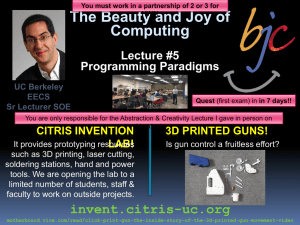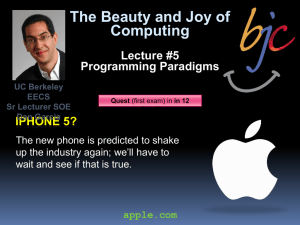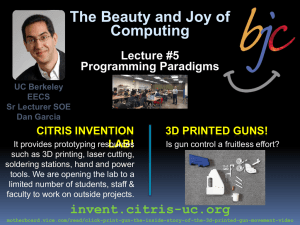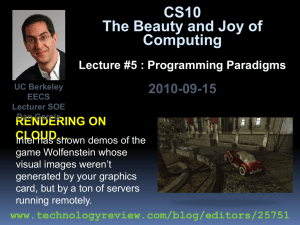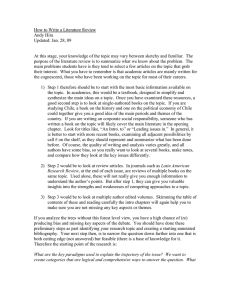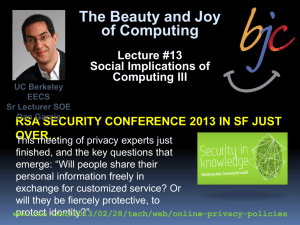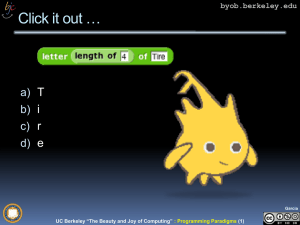CS39N The Beauty and Joy of Computing 2009-09-28
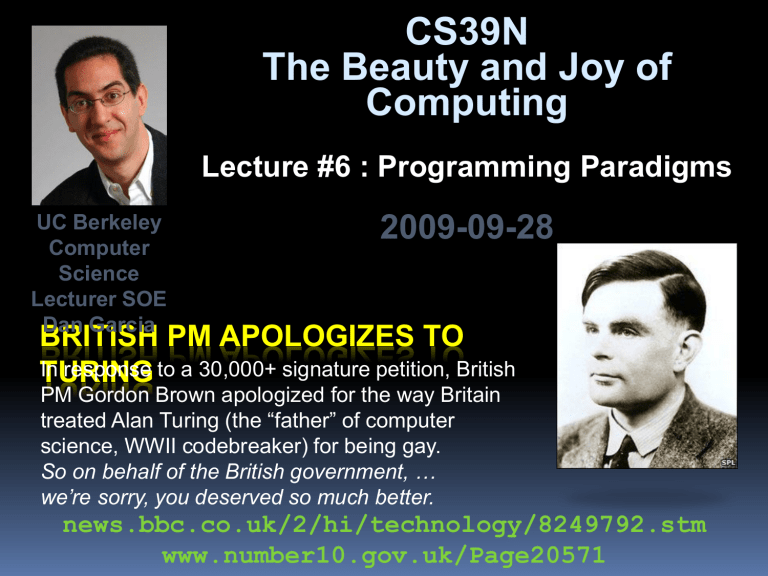
UC Berkeley
Computer
Science
Lecturer SOE
CS39N
The Beauty and Joy of
Computing
Lecture #6 : Programming Paradigms
2009-09-28
TURING
PM Gordon Brown apologized for the way Britain treated Alan Turing (the “father” of computer science, WWII codebreaker) for being gay.
So on behalf of the British government, … we’re sorry, you deserved so much better.
news.bbc.co.uk/2/hi/technology/8249792.stm
www.number10.gov.uk/Page20571
Programming Paradigms Lecture
What are they?
Most are Hybrids!
The Four Primary ones
Functional
Imperative
Object-Oriented
OOP Example:
Skecthpad
Declarative
Turing Completeness
Summary
UC Berkeley CS39N “The Beauty and Joy of Computing”
: Programming Paradigms (2)
Garcia, Fall 2009
en.wikipedia.org/wiki/Programming_paradigm
What are Programming Paradigms?
“The concepts and abstractions used to represent the elements of a program (e.g., objects, functions, variables, constraints, etc.) and the steps that compose a computation
(assignation, evaluation, continuations, data flows, etc.).”
Or, a way to classify the style of programming.
Garcia, Fall 2009
UC Berkeley CS39N “The Beauty and Joy of Computing”
: Programming Paradigms (3)
Most Languages Are Hybrids!
This makes it hard to teach to students, because most languages have facets of several paradigms!
Scratch too!
It’s like giving someone a juice drink(with many fruit in it) and asking to taste just one fruit!
UC Berkeley CS39N “The Beauty and Joy of Computing”
: Programming Paradigms (4)
Garcia, Fall 2009
en.wikipedia.org/wiki/Functional_programming
Functional Programming (review)
Computation is the evaluation of math functions
Plugging pipes together
Each pipe, or function, has exactly 1 output
Functions can be input!
f(x)=(2+3)* x x
2 3
Features
No state
E.g., variable assignments
No mutation
E.g., changing variable values
No side effects
+ f
*
Examples
Scheme, Scratch BYOB
UC Berkeley CS39N “The Beauty and Joy of Computing”
: Programming Paradigms (5) x
Garcia, Fall 2009
en.wikipedia.org/wiki/Imperative_programming
Imperative Programming
AKA “Sequential”
Programming f(x)=(2+3)* x
Computation a series of steps
Assignment allowed
Setting variables
Mutation allowed
Changing variables
Like following a recipe. E.g.,
Procedure f(x)
ans = x ans = ans ans = (2+3) * ans return ans
Examples: Pascal, C
UC Berkeley CS39N “The Beauty and Joy of Computing”
: Programming Paradigms (6)
Garcia, Fall 2009
en.wikipedia.org/wiki/Object-oriented_programming
Object-Oriented Programming (OOP)
Objects as data structures
With methods you ask of them
These are the behavoirs
With local state, to remember
These are the attributes
Classes & Instances
Instance an example of class
E.g., Fluffy is instance of
Dog www3.ntu.edu.sg/home/ehchua/programming
/java/images/OOP-Objects.gif
Inheritance saves code
Hierarchical classes
E.g., pianist special case of musician, a special case of performer : Programming Paradigms (7)
Garcia, Fall 2009
en.wikipedia.org/wiki/Sketchpad
OOP Example : SketchPad
Dr. Ivan Sutherland
“Father of Computer
Graphics”
1988 Turing Award (“Nobel prize” for CS)
Wrote Sketchpad for his foundational 1963 thesis
The most impressive software ever written
First…
Object-oriented system
Graphical user interface non-procedural language
Spent the past few years doing research @ Berkeley in EECS dept!
Garcia, Fall 2009
UC Berkeley CS39N “The Beauty and Joy of Computing”
: Programming Paradigms (8)
en.wikipedia.org/wiki/Declarative_programming
Declarative Programming
Express what computation desired without specifying how it carries it out
Often a series of assertions and queries
Feels like magic!
Sub-categories
Logic
Constraint
We saw in Sketchpad!
Examples: Prolog
Anders Hejlsberg
“The Future of C#” @ PDC2008 channel9.msdn.com/pdc2008/TL16/
Garcia, Fall 2009
UC Berkeley CS39N “The Beauty and Joy of Computing”
: Programming Paradigms (9)
en.wikipedia.org/wiki/Turing_completeness
Turing Completeness
A Turing Machine has an infinite tape of 1s and 0s and instructions that say whether to move the tape left, right, read, or write it
Can simulate any computer algorithm!
A Universal Turing Machine is one that can simulate a Turing machine on any input
A language is considered
Turing Complete if it can simulate a Universal Turing
Machine
A way to decide that one programming language or paradigm is just as powerful as another
Turing Machine by Tom Dunne
Xkcd comic “Candy Button Paper”
Garcia, Fall 2009
UC Berkeley CS39N “The Beauty and Joy of Computing”
: Programming Paradigms (10)
Ways to Remember the Paradigms
Functional
Evaluate an expression and use the resulting value for something
Object-oriented
Send messages between objects to simulate the temporal evolution of a set of real world phenomena
Declarative
Imperative
Answer a question via
First do this search for a solution and next do that www.cs.aau.dk/~normark/prog3-
03/html/notes/paradigms_themes-paradigm-overviewsection.html
Garcia, Fall 2009
UC Berkeley CS39N “The Beauty and Joy of Computing”
: Programming Paradigms (11)
Summary
Each paradigm has its unique benefits
If a language is Turing complete, it is equally powerful
Paradigms vary in efficiency, scalability, overhead, fun,
“how” vs “what” to specify, etc.
Modern languages usually take the best from all
E.g., Scratch
Can be functional
Can be imperative
Can be object-oriented!
UC Berkeley CS39N “The Beauty and Joy of Computing”
: Programming Paradigms (12)
Garcia, Fall 2009
